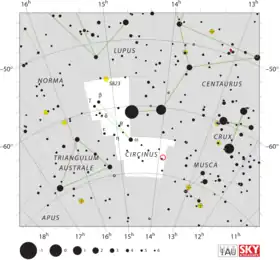FM Circini
FM Circini, also known as Nova Circini 2018, was a nova which appeared in the constellation Circinus (near the boarder with Musca) in 2018. It was discovered by John Search of Chatsworth Island, New South Wales, Australia on 19.708 January 2018, using a DSLR with a 50 mm F/1.2 lens. At the time of its discovery, it had an apparent visual magnitude of 9.1.[1] It was confirmed to be a nova spectroscopically on 21 January 2018.[3] FM Circini reached a peak brightness of magnitude 5.8 on 22 March 2018, making it visible to the naked eye.[2]
 | |
| Observation data Epoch J2000 Equinox J2000 | |
|---|---|
| Constellation | Circinus |
| Right ascension | 13h 53m 27.00s[1] |
| Declination | −67° 25′ 11.0″[1] |
| Apparent magnitude (V) | 5.8 – 17.3[2] |
| Characteristics | |
| Variable type | Nova[3] |
| Other designations | |
| Database references | |
| SIMBAD | data |

FM Circini's outburst and decline from peak brightness was observed by the Gaia spacecraft, the All Sky Automated Survey for SuperNovae and AAVSO observers.[5][6] The nova rose slowly to peak brightness, and then fluctuated between magnitude ~6.5 and ~8.5 for about three months, before beginning a nearly monotonic decline.[6] It took 150 days for FM Circini to fade from peak brightness by 2 magnitudes, which makes it a "slow" nova in the classification scheme of Cecilia Payne-Gaposchkin.[7]
The orbital period of FM Circini is 3.4898 days. The lightcurve shows modulations in the tail (after the eruption).[8]
External links
References
- "CBAT "Transient Object Followup Reports"". Central Bureau for Astronomical Telegrams. International Astronomical Union. Retrieved 12 January 2021.
- "The International Variable Star Index". aavso.org. AAVSO. Retrieved 12 January 2021.
- Strader, J.; Chomiuk, L.; Swihart, S.; Shishkovsky, L. (January 2018). "Spectroscopic confirmation of two new Galactic novae". The Astronomer's Telegram. 11209: 1. Bibcode:2018ATel11209....1S.
- "FM Cir". SIMBAD. Centre de données astronomiques de Strasbourg. Retrieved 2021-01-12.
- "Gaia18aod". Institute of Astronomy, University of Cambridge, UK. Retrieved 12 January 2021.
- Molaro, P.; Izzo, L.; Bonifacio, P.; Hernanz, M.; Selvelli, P.; della Valle, M. (March 2020). "Search for 7Be in the outbursts of four recent novae". Monthly Notices of the Royal Astronomical Society. 492 (4): 4975–4985. arXiv:1912.13281. Bibcode:2020MNRAS.492.4975M. doi:10.1093/mnras/stz3587. S2CID 209515982.
- Payne-Gaposchkin, Cecilia (1964). The galactic novae. New York: Dover. Bibcode:1964gano.book.....P.
- Schaefer, Bradley E. (2021). "Discovery of 13 New Orbital Periods for Classical Novae". Research Notes of the AAS. 5 (6): 150. arXiv:2106.13907. Bibcode:2021RNAAS...5..150S. doi:10.3847/2515-5172/ac0d5b. S2CID 235632263.